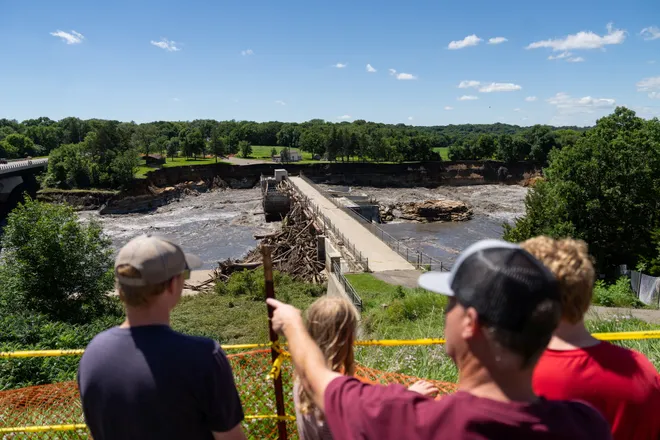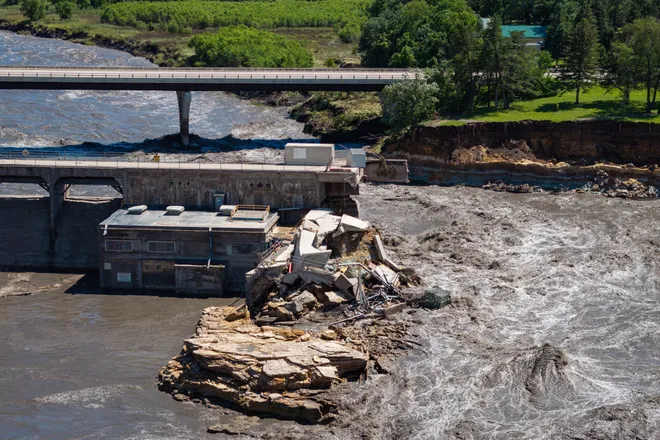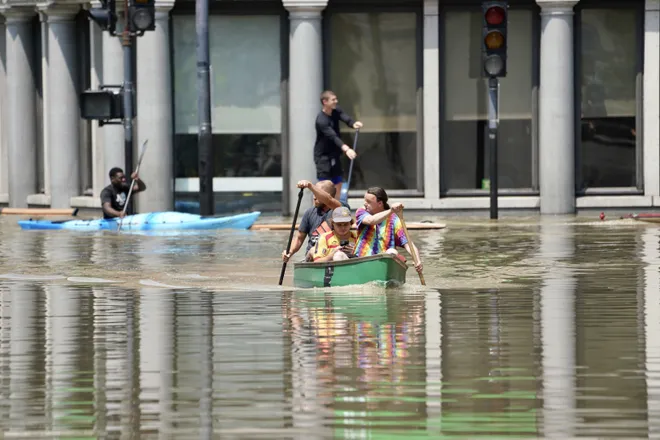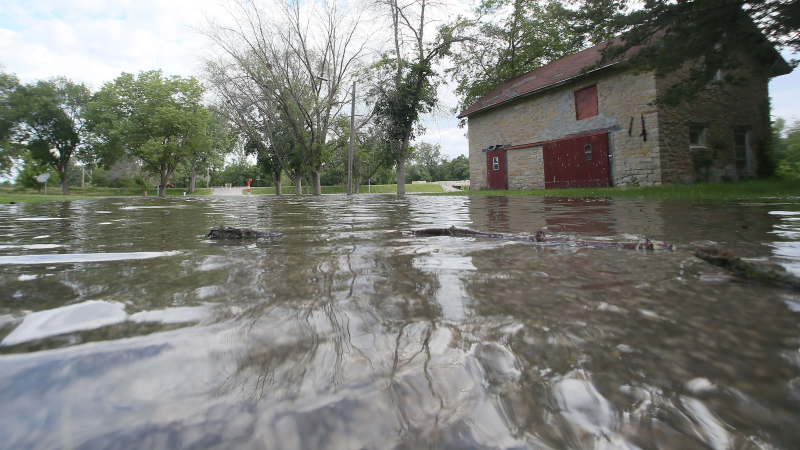As climate change makes extremes more extreme, rainfall is no different
A raging flood pulled a family's home of more than 50 years into the Blue Earth River in southern Minnesota this week, as a community watched in horror.
The river’s water flow had tripled in three days after 11 to 18 inches of rain fell in a little more than a week. The swollen river carved a new pathway around the Rapidan Dam, threatening to collapse the dam and the nearby store where the home’s owners, the Bruska family, had served up pies and shakes for decades.
Similar intense rains have pummeled much of the north-central U.S. in June, causing devastating floods across the region, with major flooding underway on the Big and Little Sioux rivers, the Des Moines River and the Minnesota River.
Such events are occurring with increasing frequency across the nation. Rain isn’t just falling, it’s breaking records, cascading at intense rates brought on by the warming climate.
Flooding has always occurred along rivers and streams, but today the warmer air allows the atmosphere to hold more water, and storms are often supercharged by the flow of moisture from warming oceans. As communities flood more often, the pressure is growing to prepare for and adapt to more frequent flooding.
That pressure is reflected in two new developments over the past month: A groundbreaking climate action law in Vermont, and a federally commissioned report that finds the government's calculations for maximum potential rainfall are no longer valid thanks to the more intense rainfall driven by climate change.

In Sioux Falls, South Dakota on June 21, the National Weather Service reported rain rates of 3-5 inches per hour. The next day, a South Florida deluge brought rain rates of 4-5 inches that flooded areas of Miami-Dade, Florida, where higher sea levels are making things worse by making it harder for the rain to drain.
"As has been shown time and time again, event after event, climate change is leading to wetter, more extreme precipitation events," said Kevin Reed, an associate provost for climate and sustainability programming at Stony Brook University who studies the impact of the warming climate on rainfall.
More than 200 stream gauges in the North Central U.S. were in various stages of flooding Friday, including the Blue Earth River, where the water had finally started to recede, according to U.S. Geological Survey data.
Read USA TODAY's rainfall investigationHow a summer of extreme weather reveals a stunning shift in the way rain falls in America.

Vermont's "great flood" drives new legislation
In Vermont, a 9-inch deluge last July triggered a devastating flood and damages estimated at $1 billion. That flooding spurred state legislators in May to approve a new law, dubbed the "climate superfund act."
"Vermont had just faced one of the most catastrophic climate disasters in its history," said Elena Mihaly, vice president of the Conservation Law Foundation Vermont, which helped lobby for the bill. "It was a very frightening time where Vermonters really felt the vulnerability."
The legislation aims to recover the costs of such climate disasters by seeking payments from large fossil fuel companies for their extraction and refining activities that caused climate-related impacts in Vermont over a period dating back to 1995.
The state plans to conduct a cost analysis to determine what the costs are to Vermont now and in the future from the extraction and refinement of the products that produce greenhouse gas emissions, Mihaly said, to help recoup costs that are now falling "entirely on taxpayers shoulders."
Gov. Phil Scott, a Republican, allowed the climate action bill to become law without his signature on May 31. The bill earmarks the money collected for climate change adaptation projects.

'Historical changes in extreme rainfall'
The National Academies of Sciences, Engineering and Medicine published the new rainfall study, sponsored by the National Oceanic and Atmospheric Administration after it was directed by Congress to bring the nation's "probable maximum precipitation" estimates into line with the changing climate.
The worst-case scenario precipitation estimates – which set the greatest depth of precipitation possible over a given duration at a particular location and time of year – are used by engineers when designing and building critical facilities such as dams and nuclear power plants. The estimates are used to reduce the risk of catastrophic flooding and build structures that can withstand extreme rainfall.
The Academies convened a committee with some of the nation's leading experts on extreme rainfall, who met in workshops with additional experts, such as Reed.
The committee found that "climate change has resulted in historical changes in extreme rainfall and the likelihood that greater changes will occur over the coming decades." Its report presents a broad range of recommendations to develop more accurate estimates by improving modeling and formulas and incorporating additional scientific research.
Climate change recalculates maximum rainfall potential
Combining the more high-tech observations available with a better understanding of extreme storms and newer high-resolution modeling can transform the old way of calculating rainfall estimates, the report stated. Updated estimates could take into account the extremes likely to occur in a warming world, and provide crucial information about the hazards that come with extreme rainfall, "including coastal storm surge and compound flooding."
Although the original intent of the precipitation estimates was to design structures that would never fail, “we’ve probably been designing things so they have a very low risk of failure but not impossible," said committee member John Nielsen-Gammon, Texas State Climatologist and regents professor at Texas A & M University. “A very low risk of failure is less comforting than no risk."
“If you don’t take climate change into account, you underestimate the risk, not just in the future but even the present day risk, because the chances of extreme rainfall have been increasing almost everywhere,” Nielsen-Gammon said. Some evidence suggests the odds of an event occurring are increasing the most for the more unusual events, he said.

On a global basis "the average annual precipitation is believed to be increasing somewhere around 2% per degree of warming," Nielsen-Gammon said. However, the "extreme precipitation rate in a given year is increasing by 7% or more per degree of warming."
The study also recommended incorporating future climate change impacts into the extreme precipitation estimates, Reed said, which can help ensure "our infrastructure and society are most resilient to these changing events."
NOAA expects to issue the first updated estimates by 2030, if the program is fully funded, according to the agency's website. After that, the legislation states the estimates should be updated at least every 10 years.
Disclaimer: The copyright of this article belongs to the original author. Reposting this article is solely for the purpose of information dissemination and does not constitute any investment advice. If there is any infringement, please contact us immediately. We will make corrections or deletions as necessary. Thank you.



